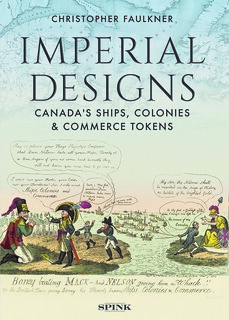
PREV ARTICLE
NEXT ARTICLE
FULL ISSUE
PREV FULL ISSUE
BOOK REVIEW: IMPERIAL DESIGNSWilliam Vanornum submitted this review of Christopher Faulkner's book, Imperial Designs: Canadian Ships, Colonies, and Commerce Tokens. Thank you! -Editor
It can be especially fruitful to compare coins from different countries when there are many numismatic similarities. The book "Imperial Designs: Canadian Ships, Colonies, and Commerce Tokens" by Christopher Faulkner is a 429+ page book published by Spink with precise and luscious design, two qualities rarely seen together in book-making. I find this important to note in a venue sponsored by the Numismatic Bibliomania Society. It opens a new vista into Canadian and United States numismatics as it brings into our careful focus the Breton 997 token--famous for its obverse of the sailing ship. I should say, "sailing shipS." On the tokens I've first observed all the ships looked the same, and maybe they were, based on my limited sample of coins. But the ships differ! It may be how the flag is flying, a cut-know, the spiritsail or the foresail, or the looping of the hanging lines. (I will leave readers to look up and learn more about these terms.) In learning about these coins one also develops expertise about ships, and the author includes a neat table-line-drawing of the ships in miniature that helps the reader identify the coins. The ships were majestic. By the 1850s they were approaching 1,000 tons and by 1864 there was one launched that weighed over 33,000 tons. Faulkner appreciates Canadian history as well as these coins through a poetic lens, and this description rivals Sheldon's reminiscence about those Old Cents in Penny-Whimsy. Here is what Faulkner has to say: "The obverse of our token recalls the days of sail, the days of 'iron men and wooden ships,' to pirate a well-worn phrase, days which filled years, decades, and centuries, when the only way to reach the rest of the world from North America, was by crossing oceans under the power of wind and tide. For 350 years every single one of millions of immigrants to North America came by ship, to ports east and west, north and south, around a vast continent. For 350 years every stick of lumber, every grain of wheat, every fillet of fish, every pelt of fur that left North America left by ship. And every manufactured good of tin or plate, cotton or silk, crystal or porcelain, came here by ship..." (Faulkner, 2019, p. 5). For me it was interesting to see the parallel development of numismatics in Canada and the United States in the study of the coins and tokens displaying the most individual varieties. Breton Token Type 997 has 46 varieties, reminding me of the Early American Cents of 1794, and of the many varieties of other early coins and tokens in North America, such as the many varieties of early colonial coins; the New Jersey coppers, for some reason, come to mind as I am typing this. There is an honorable lineage of numismatists in Canada studying these tokens, with the following names constituting a particular Hall of Fame: Jeremiah Gibbs, Howland Woods, W.A.D. Lee, Carrol Holmes, Lorne Wilson, as well as those who established major collections. Many of the 997 tokens appear to be available in highly collectible condition, and by this I mean upper 2-figures and lower 3-figures. There is a feast to be had and an afterglow that will result from careful study. Those who study early American coins will find their numismatic skill-set extremely applicable to these tokens; this is similarly so in a reciprocal fashion for Canadian specialists. Wouldn't it be neat to have a folder for collecting these coins? Perhaps someone at Whitman, Dansco, or another company will consider this. Faulkner even provides us with a song sung at the opening of the East Country Dock in Rotherhithe on March 21, 1811 (Faulkner, 2019, p. 21). One imagines the feasting and libations accompanying these verses!
"Not a Colony, then, has he got in the world,
Enjoy the book, create a new focus for your hobby.
To read the earlier E-Sylum article, see:
Wayne Homren, Editor The Numismatic Bibliomania Society is a non-profit organization promoting numismatic literature. See our web site at coinbooks.org. To submit items for publication in The E-Sylum, write to the Editor at this address: whomren@gmail.com To subscribe go to: https://my.binhost.com/lists/listinfo/esylum All Rights Reserved. NBS Home Page Contact the NBS webmaster 
|

